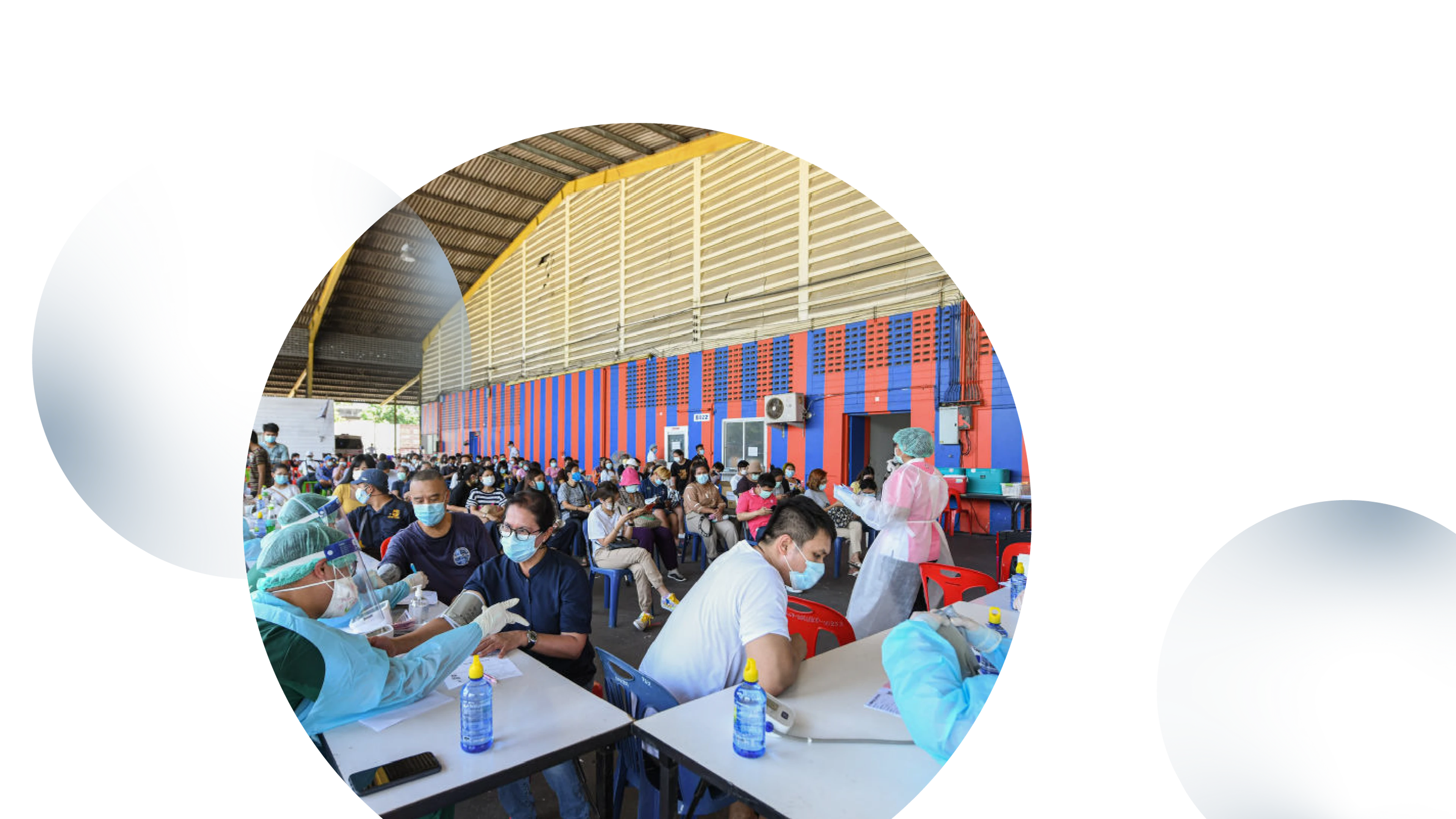The 100 Days Mission - how close are we?
Published: July 24, 2024
Two years on from the inaugural Global Pandemic Preparedness Summit hosted in London, Kate Kelland explores the progress that has been made towards the 100 Days Mission and what needs to happen to help the world respond to the next Disease X in as little as 100 days.
Two years ago, in a world reeling from the COVID-19 pandemic, CEPI and its partners set out an ambitious goal: to prepare the world to respond to and contain future pandemic threats within 100 days. We described this 100 Days Mission as a “moonshot” – a stretching but feasible plan to help humanity get ahead of the next potential pandemic.
Since that time, there have been multiple sporadic and persistent human outbreaks of deadly viral infectious diseases in countries all across the world. And that’s not including COVID-19. With ever more frequent extreme weather events and ever present environmental and climate change, the risk of new epidemics and potential pandemics has never been higher.
Some of the recent pathogenic outbreaks are caused by old foes, re-emerging. Others are new, dangerous mutations of previously known culprits.
In Uganda in late 2022, there was an outbreak of Sudan Ebolavirus—a viral relative of the Zaire Ebolavirus strain that devasted parts of West Africa in 2014-16. In South America, a large outbreak of Dengue fever continues to spread, particularly in Brazil where more than nine million cases and 4,700 deaths have been reported so far this year. Also in South America—in Brazil, Paraguay, Argentina and Bolivia—as well as in several countries in Asia, epidemics of Chikungunya have been raging for months, causing hundreds of thousands of cases and hundreds of deaths.
A deadly outbreak of Mpox, a viral relative of the fearsome but now eradicated Smallpox virus, is spreading in the Democratic Republic of Congo where it is increasingly threatening the lives of children and young adults. Nigeria and some of its close neighbours in West Africa are suffering larger and more persistent outbreaks of the rat-borne Lassa fever. In Bangladesh and India, the deadly brain-invading virus Nipah has infected scores of people in sporadic attacks. And in the United States, there’s now a worrying situation with an outbreak of highly pathogenic H5N1 bird flu among cattle and poultry that has already sparked at least 11 human cases of spillover infection.
“Given the warning signals that these multiple viral disease outbreaks are sending us, it’s clear that the urgency of the 100 Days Mission cannot be overstated,” says CEPI’s Chief Executive Officer Dr Richard Hatchett.
The 100 Days Mission is a plan that would see the world equipped to be able to deliver medical countermeasures against any potential viral pandemic threat, be it a re-emerging known pathogen or a novel Disease X, within a little over three months.

So, how close is the world to being mission ready?
The good news is that the global community now has a vision for how to get ahead of future disease outbreaks by shortening the period between the viral sequencing of a new pathogenic threat and the emergency authorisation of vaccines to just over three months. And it is uniting behind it.

In September 2023, United Nations Member States approved a declaration calling for concerted action on pandemic preparedness at the UN General Assembly. At COP28, more than 140 countries backed a Declaration on Climate and Health that linked human, animal, environment and climate health and called for intensification of efforts to detect zoonotic spillovers. The 100 Days Mission has been embraced by both the G7 and G20 groups of nations and taken up in specific pandemic planning policies by several national governments, including those of Japan, Korea, the United States and the United Kingdom.
Importantly, those many political leaders who have endorsed the 100 Day Mission have done so fully recognising that this is not just a scientific challenge, but also a test of global leadership, political resolve and scientific and strategic cooperation.
As CEPI emphasised when it launched the 100 Days Mission, global pandemic preparedness is not a single, simple step. Nor is it something that any one country, organisation or institution can achieve alone. It is a series of incremental gains – broadening, expanding, honing, training, accelerating, refining and sharpening the world’s collective abilities to spot, respond to and ultimately neutralise incipient infectious disease pandemics—coupled with a paradigm shift in the world’s pandemic preparedness and response system.
But two years on from CEPI’s rallying call for the world to join together on this mission, it’s fair to ask: if there were to be a novel or re-emerging Disease X outbreak now, is the global health security ecosystem closer to being ready and able to respond effectively within just 100 days?
The answer is that it depends.
Scientists are largely agreed that the next viral threat – the next Disease X – is highly likely to emerge from one of 25 or so families of viruses that have already shown an ability to infect and cause disease in people.
That means that a critical element of the pandemic-busting 100 Days Mission is for the world to create a library of as much vaccine development knowledge and data about as many as possible of the pathogens within those 25 viral families. Then, when the next Disease X emerges—and we can be sure that is not if, but when—the world won’t be starting from scratch in designing and developing defences against it.
Gaining that viral family expertise to create such a library, building the technical know-how and advancing the scientific understanding of how to combat or defend against as-yet-unknown viruses, and then bringing that knowledge together to make it accessible wherever and whenever it is needed, is a huge and complex task. But we’ve made a good start.

Getting to know the unknowns
Take the Arenaviruses for example – one of those 25 or so “Viral Most Wanted” families of pathogens that could very well present a future epidemic or pandemic threat. While there is one licenced vaccine against an Arenavirus—a shot called Candid#1 designed to protect against Junin virus—until relatively recently, there were very few new vaccines in development against viruses in this family. That meant that scientists could feel little confidence in how the world could counter an outbreak caused by a novel or re-emerging Arenavirus.
Now though, researchers are able to put more pieces of this part of the puzzle in place. Vaccinologists are developing potential defences against Lassa virus, a prime suspect in the Arenavirus family and a pathogen that already causes repeated and increasingly severe outbreaks of disease in Nigeria and other parts of West Africa. CEPI is now supporting the development of multiple Lassa vaccine candidates, including one that began mid-stage human trials this year. CEPI has also teamed up with scientists working on the early development of prototype Junin vaccines built on rapid response platforms.
Work on how to combat new potential pandemic threats in the Paramyxovirus family has progressed similarly, putting a few more key pieces of that part of the puzzle into place. The Paramyxovirus family contains both measles—the most contagious of all known human viruses— and Nipah—one of the deadliest known human diseases. Any progress in designing safe and effective medical defences against these viral disease threats is also progress towards pandemic preparedness and the 100 Days Mission.
A vaccine to prevent Hendra virus infection in horses has been available for around a decade and scientists are now testing a subunit formulation of that vaccine, targeting the same viral protein, for its potential to prevent human Hendra infection. Against Nipah, several new candidates using different types of technology are currently in development, including three supported by CEPI. One of those is being led by scientists at the University of Oxford in the UK, a second is led by Auro Vaccines and PATH in the United States, and a third by the U.S. biotech Public Health Vaccines. And all three have recently advanced into human testing.
This breadth of scientific work on Hendra and Nipah brings the prospect of approved safe and effective vaccines against these potential killers into view, at the same time as making significant progress in the 100 Days Mission. By deepening scientific understanding of a viral family that harbours some of the most worrying pandemic threats—in other words, by knowing more about the unknowns—the global health security system is becoming better prepared.
Against Coronaviruses, another of the most urgent pandemic threats, the world’s potential defences are now orders of magnitude more robust and responsive than they were before COVID-19 hit. Thanks in part to the accelerated work prompted by the emergence of the novel Coronavirus SARS-CoV-2, there are multiple safe and effectives vaccines against COVID-19, some of which are currently being adapted to target new variants. And scientific teams around the world are already working on a next generation of tools designed to be broadly protective against several coronaviruses and their variants. The hope is that this could one day lead to the development of pan-coronavirus vaccines—shots that could pre-empt the evolution of new variants or sub-variants of COVID-19 and be a defence against threats posed by novel Coronaviruses that have yet to emerge.
Scientific efforts to build critical knowledge and data on the most high-risk viral families now also involve computer-assisted immunogen design using Artificial Intelligence (AI) applications to design and create new disease defence constructs. This approach has already significantly boosted researchers’ ability to forecast viral mutations and to test and develop immunogens for vaccine candidates against a future novel Disease X.

Coming ever closer
At CEPI, the focus is on driving forward the most extensive research and the most prolific and strategic innovation before a pandemic emerges. By accelerating future solutions in advance for medical defence development against these threatening viral families, there’s no doubt we’re coming ever closer to being able to develop potentially pandemic-busting vaccines in 100 days.
“How close we are, and how close we could be, depends on several factors—including the precise nature of the next Disease X pandemic threat, what infectious disease specialists already know about it, and whether the scientific community has already developed and approved safe and effective vaccines for a related virus,” says Hatchett.
If that threat were to emerge in the guise of another novel Coronavirus, for example, confidence is now greater that the world’s scientific community could develop new vaccines in record time following the game-changing advances in vaccinology made during the recent pandemic.
If it were a novel Poxvirus—a further mutation or new strain of Mpox for example—the world could equally be more confident of being able to respond more effectively because of the viral and vaccine knowledge scientists harnessed to eradicate Smallpox in the 1980s and have built on with Mpox in recent years.
If it were a novel Paramyxovirus—a viral relative of Nipah or a mutant strain of Hendra—confidence levels at this stage would be lower, mainly because we still have much to learn about this very large, complex and genetically diverse viral family and about how to develop effective medical countermeasures against it.
CEPI’s “What Will it Take” report, published in late 2022, outlined several critical areas where progress was needed to make delivery of pandemic vaccines within 100 days a reality.
Beyond starting to build a library of knowledge, data and technical know-how on developing rapid-response vaccines against pathogens from the viral families with greatest pandemic potential, the report also identified the need for global networks for clinical trials and laboratory work, enhanced disease surveillance and expanded, diversified manufacturing capabilities.
On these fronts too, the global health security system is gaining strength and advancing towards being 100 Days Mission-ready.
The World Health Organization Hub for Pandemic and Epidemic Intelligence, set up in late 2021, is working across countries and regions to enhance the world’s ability to detect new events with pandemic potential and to monitor disease control measures on a real-time basis. Working on the basis that the scientific expertise needed to detect novel and re-emerging disease outbreaks are most useful in the hands of people most directly affected by them, it has developed a framework for collaborative surveillance, established a new International Pathogen Surveillance Network to build vital data-sharing platforms and is exploring new ways of connecting and translating information from multiple diverse sources.
Joining forces with U.S. researchers using AI to help scan for and spot the next potential Disease X threat, CEPI is supporting the expansion of “SpillOver”, a viral ranking app that directly compares the risks posed by animal and human viruses. The database ranks hundreds of virus, host, climate and environmental risk factors to identify viruses with the highest risk of zoonotic spillover from wildlife to people and to highlight those most likely to spread and cause human outbreaks.
This enhanced surveillance approach also aligns with work by the World Health Organization, which is updating its list of priority pathogens to pinpoint representative viruses within the most dangerous viral families for more urgent and targeted scientific attention.
Such new disease surveillance and defence initiatives are already putting us a few steps further along the way to knowing where and when the next Disease X might emerge, what it might look like, and the severity of disease it may be able to inflict on us.
In laboratory and manufacturing diversity, things are also moving—or rather spreading—nicely. The World Health Organization has set up its first mRNA technology transfer hub in Cape Town, South Africa with the goal of building capacity and capability in Global South countries to produce mRNA vaccines. In late 2023, in a first for Africa, a new commercial-scale mRNA vaccine-making facility was inaugurated in Rwanda.
Having the capability to produce safe and effective new vaccines against an emerging disease across many countries and all regions—particularly less wealthy ones—will be vital to enabling swift and equitable access to those vaccines. It will also accelerate the pace of any global response, getting vaccines and other medical countermeasures first to those people who are most vulnerable, regardless of wealth—the ultimate aim of the 100 Days Mission.
CEPI too is establishing a global manufacturing network, with partners already on board in South Africa, India and Indonesia, to help shore-up this capability.

5 areas of innovation needed to make delivery of pandemic vaccines within 100 days a reality
Not yet close enough
There is, for sure, a very long way still to go before the international community can boast a global health security system that could without doubt contain and neutralise any novel Disease X pandemic threat within 100 days. When CEPI called on the world to join it on the mission to get 100 Days Mission-ready, it also underscored the enormity of the task and the substantial investments of time, effort and money it requires. All that remains true.
Taking stock of the progress the world has made just in the last two years, however, there are good grounds for optimism. We are moving convincingly in the right direction.
Important amendments to the International Health Regulations agreed at this year’s World Health Assembly will bolster the world’s ability to detect and respond to future outbreaks—although negotiations on the Pandemic Agreement and the opportunity it presents to build a safer future are still a work-in-progress. Virus hunters know more about more of the most pernicious viral families. Scientists know more about how to harness AI to accelerate key aspects of vaccine design and to enhance our ability to scan the horizon for potential Disease X spillover events. Manufacturers are creating more capability and capacity to produce epidemic and pandemic countermeasures in more countries and regions, making a swift and equitable response more possible in future. And the world recognises, at least in theory, the acute need for and ultimate value of pandemic preparedness that leaves no-one behind.
Preventing epidemics requires sustained commitment from all levels and all sectors of communities, societies and populations. From scientists to funders to politicians to the public, the international community cannot afford to let its guard down and allow its focus to be drawn to other crises. Despite the many other challenges—of conflict, climate change and political instability—the progress the world is making on the 100 Days Mission is manifest reason for optimism. It must be sustained.
That’s why the Brazilian government, the country’s leading health research institution Fiocruz and CEPI are co-hosting the second Global Pandemic Preparedness Summit on July 29-30 in Rio de Janeiro – this year’s ‘Capital of the G20’. By bringing together global health security leaders, research scientists, disease surveillance experts and pandemic watchers, the summit aims to drive forward the global mission to be ready to respond swiftly and equitably to novel disease threats.
“We have a once-in-a-generation opportunity to change the way the world prepares for and responds to pandemics. While the world is still far from fully prepared, the 100 Days Mission is very clearly in sight. Global progress towards it is steady—sometimes frustratingly so—but real,” says Hatchett.
“The individual breakthroughs and successes, the incremental gains in pace and know-how, are all steps that contribute to the head start we will need when the next pandemic threat emerges. And they are testament to what can be achieved when the world unites behind a common cause.”

Kate Kelland is CEPI’s Chief Scientific Writer and the author of DISEASE X – The 100 Days Mission to End Pandemics, published by Canbury Press
